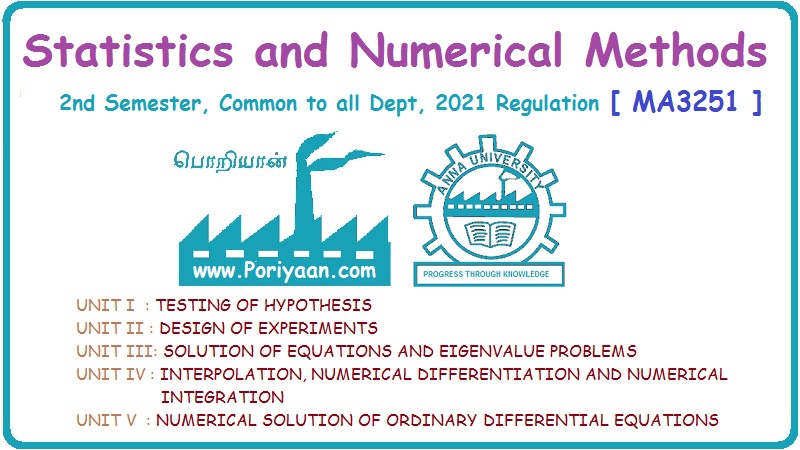Statistics and Numerical Methods: Unit II: Design of Experiments
Two - Way Classification
Merits, Demerits, Solved Example Problems | Design of Experiments | Statistics
In two-way classification of analysis of variance, we consider one classification along column-wise and the other along row-wise.
TWO-WAY CLASSIFICATION
In
two-way classification of analysis of variance, we consider one classification
along column-wise and the other along row-wise.
RBD
[Randomized Block Design]
Let
us consider an agricultural experiment using which we wish to test the effect
of 'k' fertilising treatments on the yield of crops. We assume that we know
some information about the soil fertility of the plots. Then, we divide the
plots into 'h' blocks, according to the soil fertility each block containing
'k' blocks. Thus, the plots in each block will be of homogeneous fertility as far
as possible within each block, the 'k' treatments are given to the 'k' plots in
a perfectly random manner, such that each treatment occurs only once in any
block. But the same k treatments are repeated from block to block. This design
is called Randomized Block Design.
The
scheme is most readily understood by visualising a field plan for an
agricultural experiment, say for four treatments (A, B, C, D) in six blocks of
four plots.
PLOTS
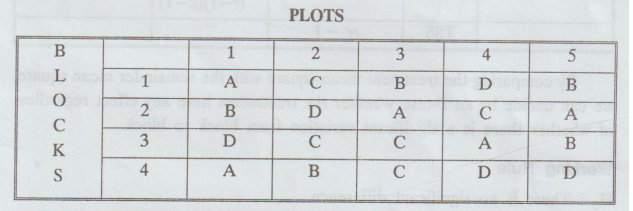
Merits
and Demerits of Random Design
Merits
1.
It has a simple layout.
2.
The design controls the variability in the experimental units and gives the
treatments equivalence to show their effects. nolistuotes sprismA
3.
The analysis of the design is simple and straight forward as in the case of two-way
classification of analysis of variance.
4.
The analysis is possible, even in the case of missing observations.
Demerits
1.
The design is not suitable for large number of treatments, since in this case
the block size is large and hence homogeneity of units may not be possible.
2.
Unequal number of replications for equal treatment is not possible.
3. The shape of the experimental material should be rectangular.
4.
It controls the variability in one direction only. aslo yew-owl al
5.
The analysis of this decision is not as simple as a completely randomized
design. Ingles old boximobas
The
analysis of variance table for a randomized block design will, in general, have
the following form.
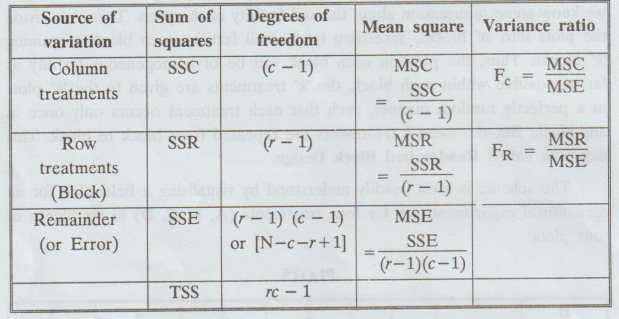
with the remainder mean square, we can
decide by an F-test, whether the treatments have any effect regardless of
whether there is a significant variation from block to block.
Working
Rule
H0
: There is no significant difference.
H1
: There is a significant difference.
Test
the hypothesis that variation between varieties and between blocks do not
differ significantly from the variance due to random errors.
Arrange
calculation of sum of squares.
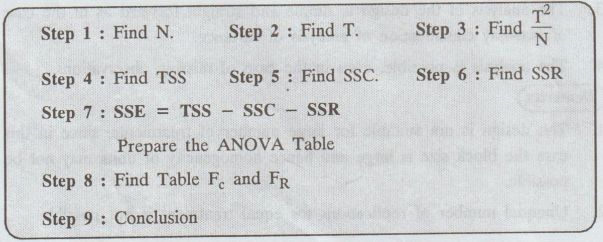
Example
2.3.1
An
experiment was designed to study the performance of 4 different detergents for
cleaning fuel injectors. The following "cleanliness" readings were
obtained with specially designed equipment for 12 tanks of gas distributed over
3 different models of engines:

Perform
the ANOVA and test at 0.01 level of significance, whether there are differences
in the detergents or in the engines.
[A.U.
Model] [A.U. N/D. 2004] [A.U CBT A/M 2011] [A.U M/J 2007, N/D 2008] [A.U N/D
2015 R13]
Solution:
The
above data are classified according to criteria (i) Detergent (ii) Engine.
In
order to simplify calculations, we code the data by subtracting 50 from each
figure.
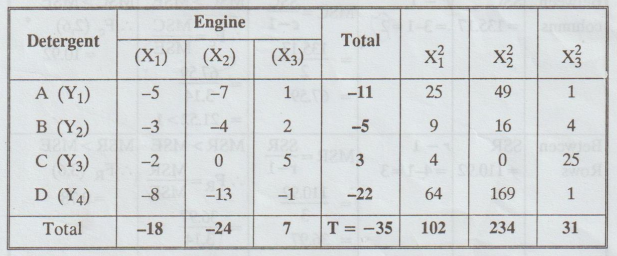
H0
: There is no significant difference between column means as well as
H1
: There is significant difference between column means or the row means.
Step
1: N = 12
Step
2: T = -35
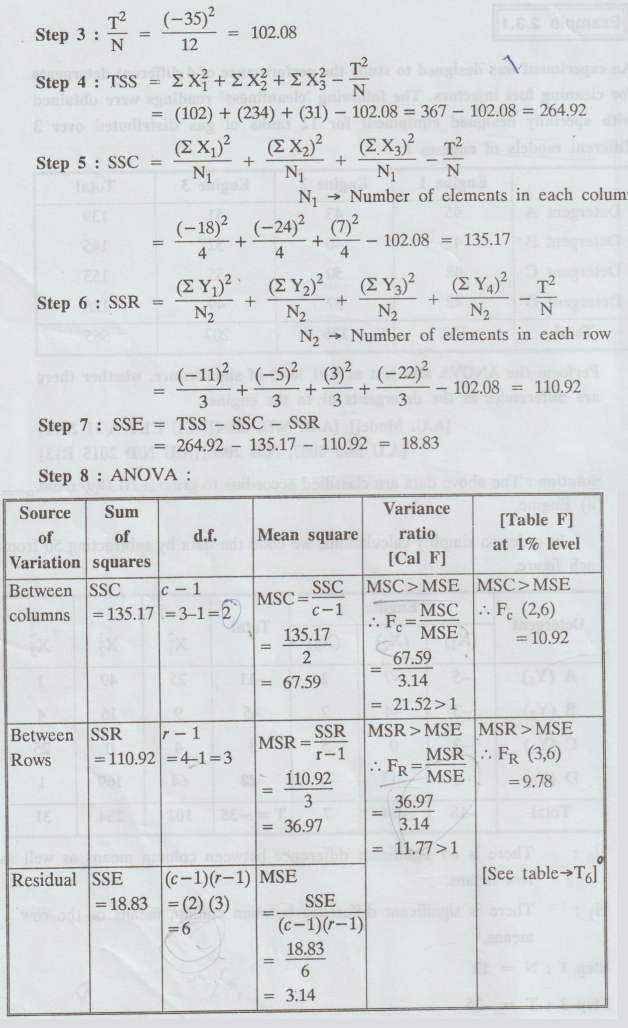
Step
9 : Conclusion .
(i)
Cal Fe > table Fe, i.e., 21.52 > 10.92
So,
we reject Ho for this case.
i.e.,
There are significant differences in the engines.
(ii)
Cal FR > table FR, i.e., 11.77 > 9.78
So,
we reject H0 for this case.
i.e.,
There are significant differences in the detergents.
Example
2.3.2
Perform
two-way ANOVA for the given below:

Use
coding method, subtracting 40 from the given numbers. [A.U. N/D 2005]
Solution:
Subtract
40 from all the numbers. By doing so, F ratio is unaffected and reduces the
numbers to smaller numbers.
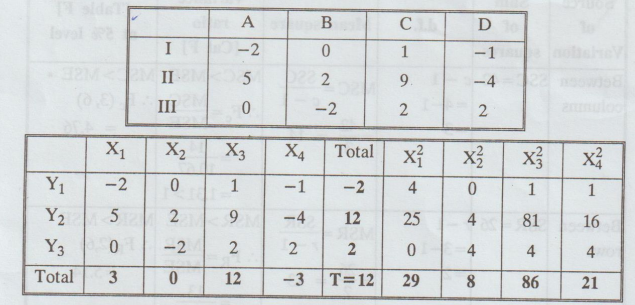
H0
: There is no significant difference between column means as well as
H1
: There is significant difference between column means or the row means.
Step
1: N = 12
Step
2: T = 12
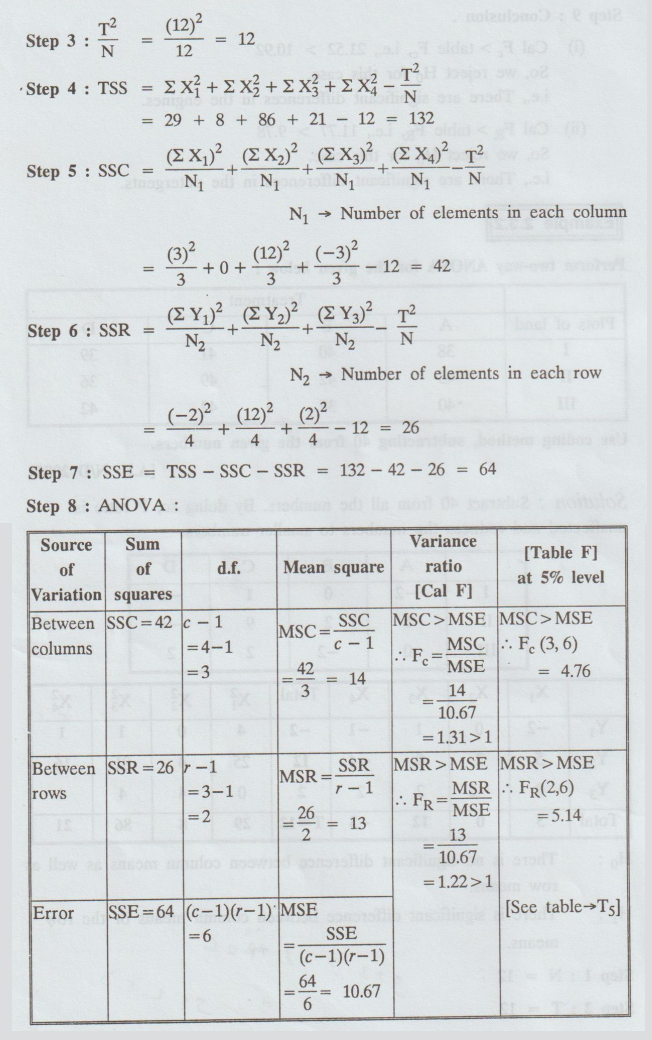
Step
9: Conclusion :
(i)
Cal Fc < table Fe, i.e., 1.31 < 4.76
So,
we accept Ho for this case.
i.e.,
There is no significant difference between treatments.
(ii)
Cal FR < table FR, i.e., 1.22 < 5.14
So,
we accept Ho for this case.
i.e.,
There is no significant difference between plots.
Example
2.3.3
Analyse
the following RBD and find your conclusion.
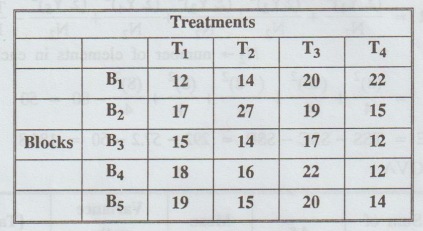
[A.U N/D 2013]
Solution
:
H0
: There is no significant difference between column means as well
H1
: There is significant difference between column means or the row means.
Subtract
15 from each number.
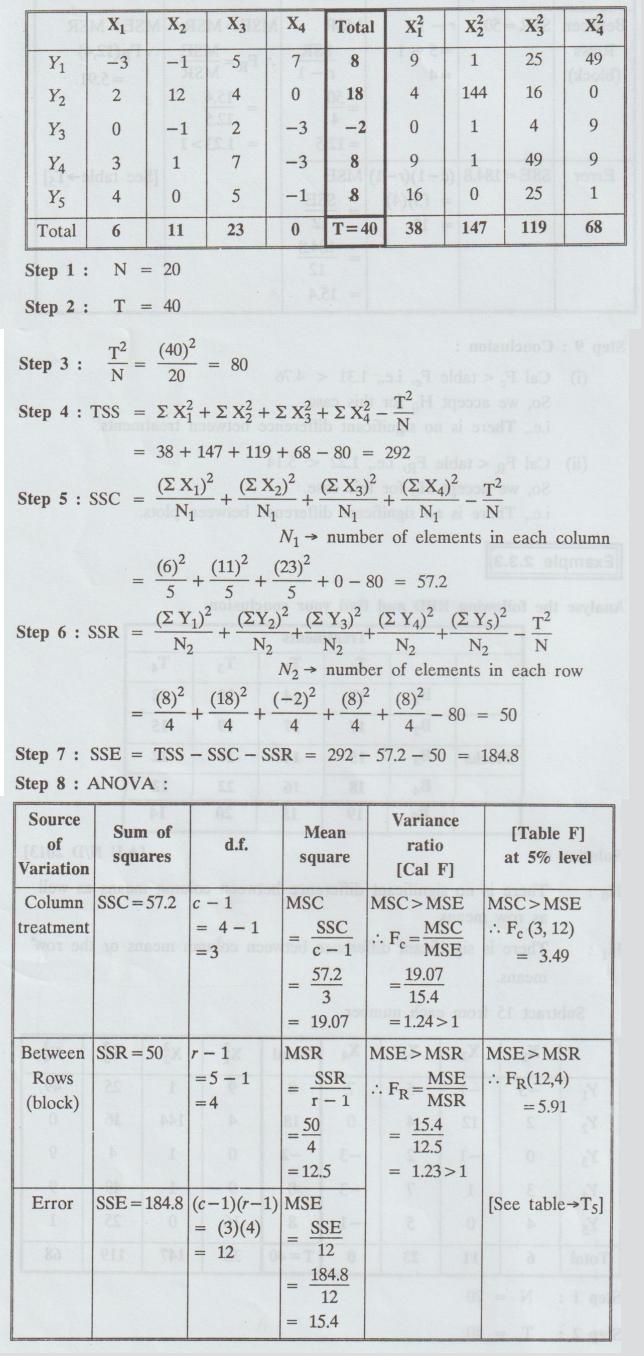
Step
9 : Conclusion :
(i) Cal Fe < Table Fe, i.e., 1.24 <
3.49.
So,
we accept Ho for this case.
i.e.,
there is no significant difference between treatments.
(ii)
Cal FR < Table FR, i.e., 1.23 < 5.91. So, we accept
H0 for this case.
i.e.,
there is no significant difference between blocks.
Example
2.3.4
The
following table gives monthly sales (in thousand rupees) of a certain firm in
the three states by its four salesmen.
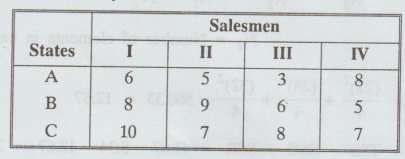
Setup
the analysis of variance table and test whether there is any significant
difference (i) between sales by the firm salesmen and (ii) between sales in the
three states.
Solution
:
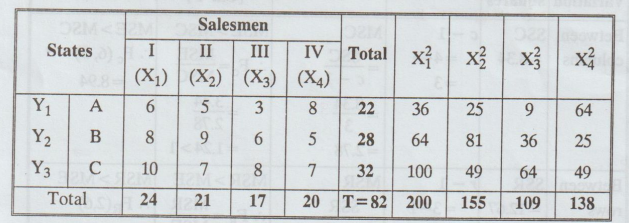
H0
: There is no significant difference between column means as well as
H1
: There is significant difference between column means or the row means.
Step
1: N = 12
Step
2: T = 82
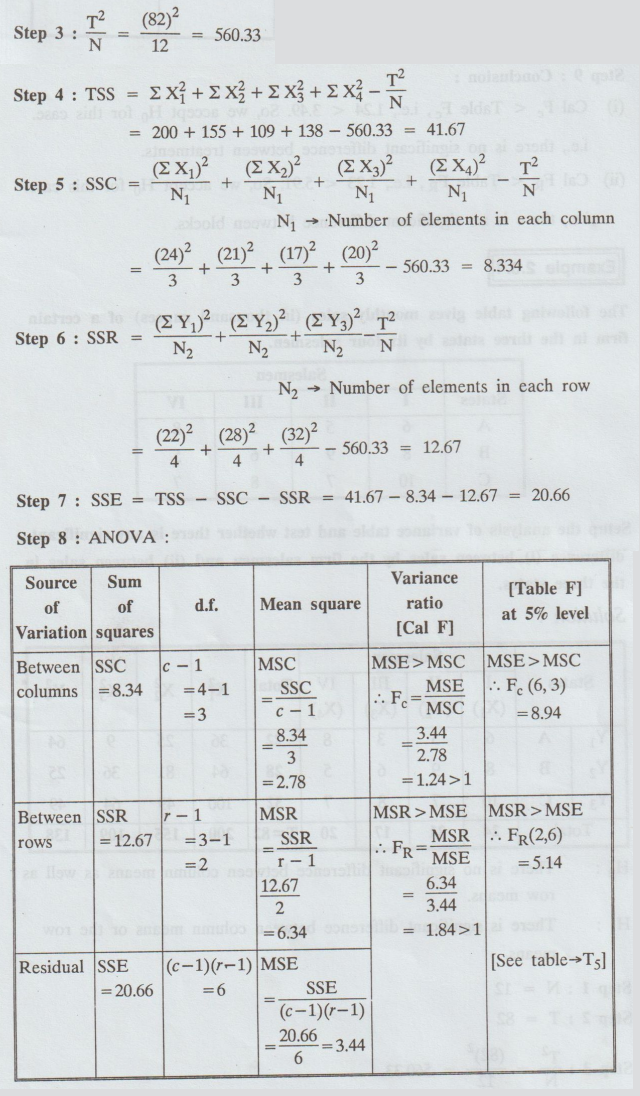
Step
9: Conclusion : 0
(i) Cal Fe < Table Fe, i.e., 1.24 < 8.94.
So, we accept H0 for this case. i.e., there is no significant
difference between salesmen.
(ii)
Cal FR < Table FR, i.e., 1.84 < 5.14. So, we accept H0 for
this case.
i.e.,
there is no significant difference between states.
Example
2.3.5
A
tea company appoints four salesmen A, B, C and D and observes their sales in
three seasons summer, winter and monsoon. The figures (in lakhs) are given in
the following table.

(i) Do the salesmen significantly differ in
performance ?
(ii)
Is there significant difference between the seasons? 02M
[A.U N/D 2012] [A.U M/J 2016 R13]
Solution:
We code the data by subtracting 30 from each figure.
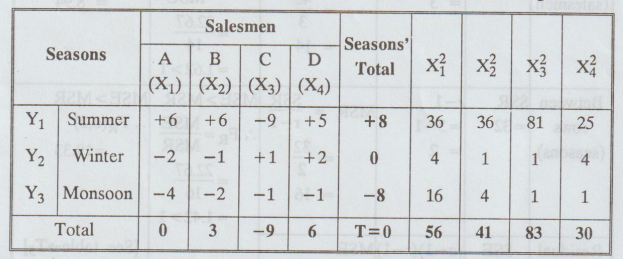
H0
: There is no significant difference between column means as well as row means.
H1
: There is significant difference between column means or the row means.
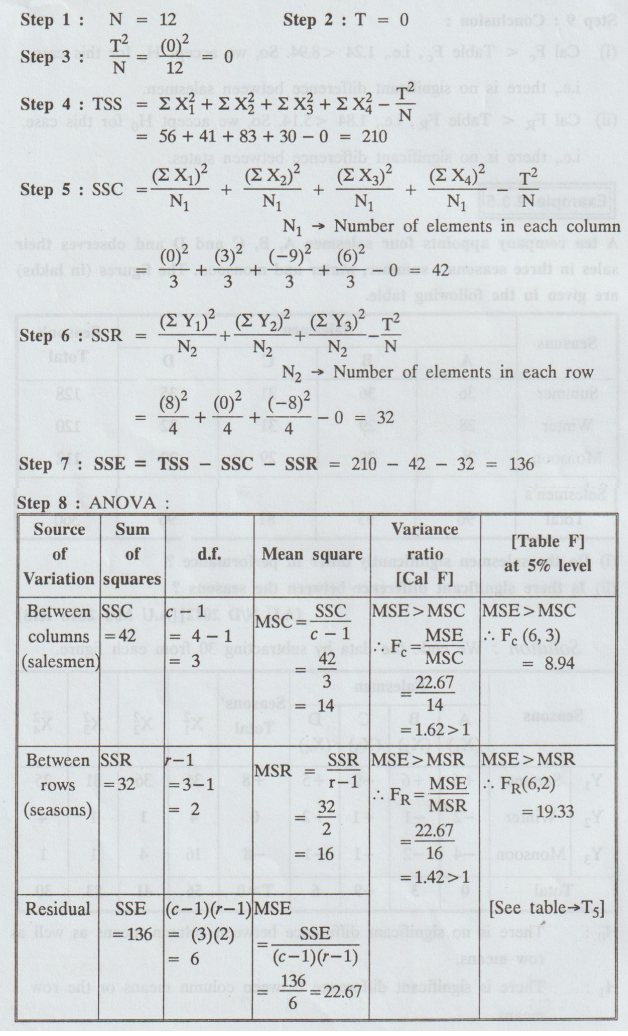
Step
9 Conclusion :
(i)
Cal Fe < Table Fe, i.e., 1.62 < 8.94. So, we accept Ho for this case.
i.e.,
there is no significant difference between salesmen.
(ii)
Cal FR < Table FR, i.e., 1.42 < 19.33. So, we accept Ho for this case.
i.e.,
there is no significant difference between seasons.
Thus,
the test shows that the salesmen and the seasons are alike, so far as the sales
are concerned.
Example
2.3.6
A
set of data involving "four tropical feed stuffs A, B, C, D" tried on
20 chicks is given below. All the twerty chicks are treated alike in all
respects except the feeding treatments and each feeding treatment is given to 5
chicks. Analyze the data.
Weight
gain of baby chicks fed on different feeding materials composed of tropical
feed stuffs. [A.U A/M 2010] [A.U A/M 2017 R-13] [A.U N/D 2019 R-13]

Solution
:
H0
: There is no significant difference between column means as well as row means.
H1
: There is significant difference between column means or the row means.
Subtract
50 from each value
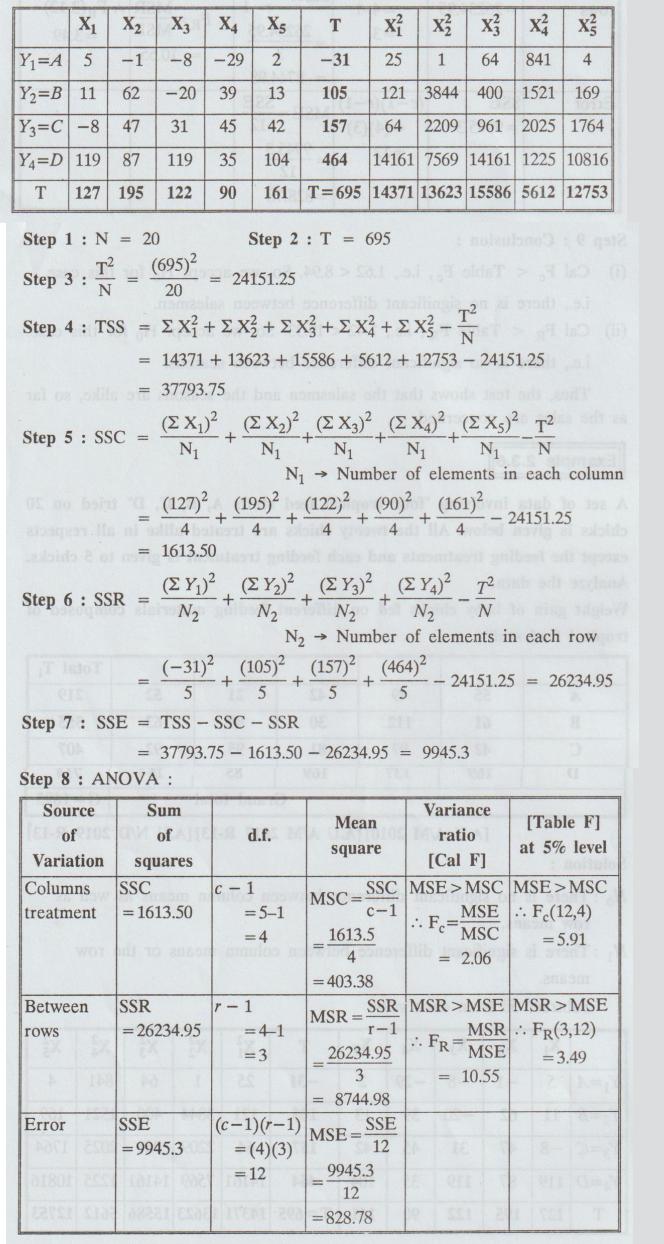
Step
9 : Conclusion:
(i)
Cal Fe < Table Fe, i.e., 2.06 < 5.91. So, we accept H0 for
this case.
i.e.,
there is no significant difference between column means.
(ii)
Cal FR > Table FR, i.e., 10.55 > 3.49. So, we reject H0 for
this case.
i.e.,
there are significant differences in row means.
Example
2.3.7
Three
varieties A, B and C of a crop are tested in a randomised block design with
four replications. The plot yield in pounds are as follows :

Analyse
the experimental yield and state your conclusion.
[A.U
N/D 2011] [A.U A/M 2019 R-13]
Solution
:
Calculation
of Correction factor
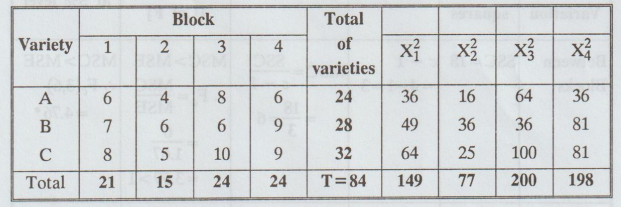
H0
: There is no significant difference between column means as well as
H1
:There is significant difference between column means or the row means.

Step
9 Conclusion :
(i)
Cal Fe < Table Fe, i.e., 3.59 < 4.76. So, we accept Ho for this case.
i.e., there is no significant difference between blocks.
(ii)
Cal FR Table FR, i.e., 2.4 < 5.14. So, we accept Ho
for this case.
i.e.,
there is no significant difference between varieties.
Example
2.3.8
Four
varieties A, B, C, D of a fertiliser are tested in a randomized block design
with 4 replication. The plot yields in pounds are as follows : [A.U M/J 2014]

Analyse
the experimental yield.
Solution:
Calculation
of correction factor
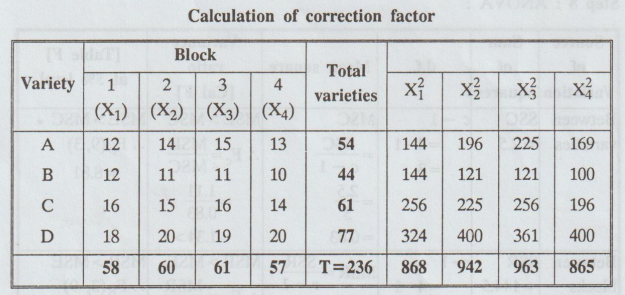
H0
: There is no significant difference between column means as well as row
means.
H1
: There is significant difference between column means or the row means.
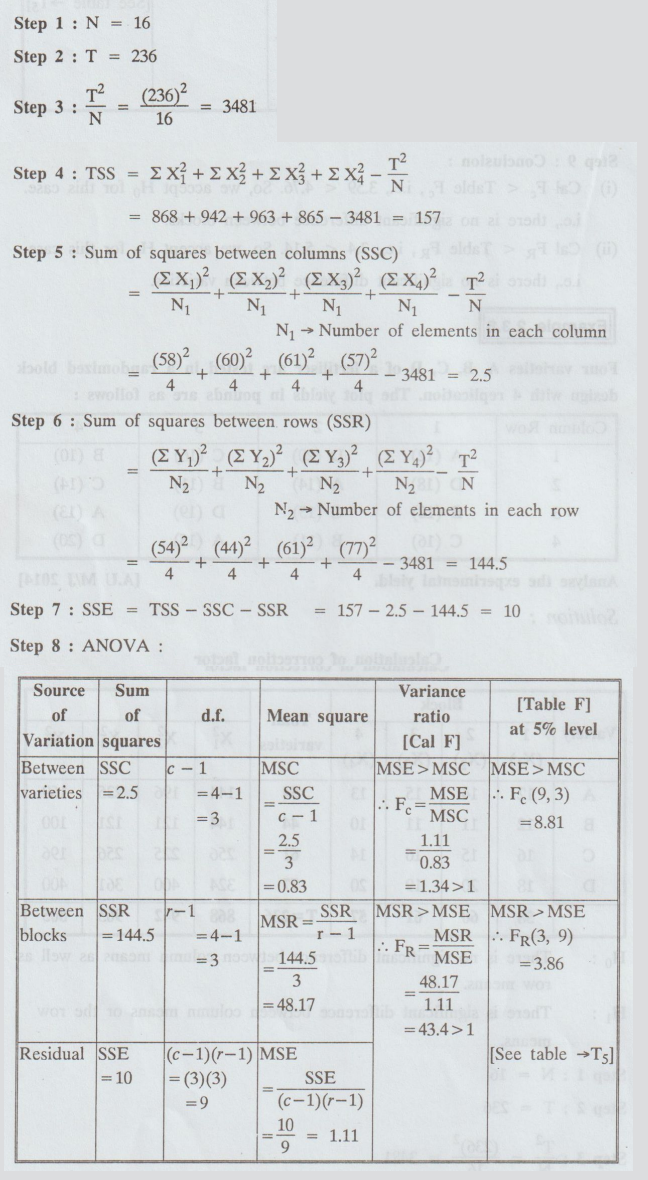
Step
9: Conclusion :
(i) Cal Fe < Table Fe, i.e., 1.34 8.81. So,
we accept Ho for this case.
i.e.,
there is no significant difference between blocks.boo
(ii)
Cal FR > Table FR, i.e., 43.4 > 3.86. So, we reject Ho for this case.
i.e.,
there are significant differences in the varieties.
Example
2.3.9
The
following data represent the number of units production per day turned out by
different workers, using 4 different types of machines.
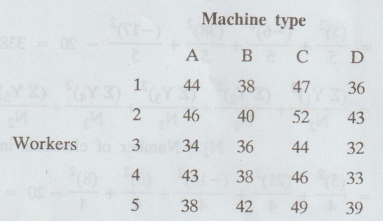
Test
whether the five men differ with respect to mean productivity and test whether
the mean productivity is the same for the four different machine types. [A.U.
M/J 2006, N/D 2007, M/J 2013] [N/D 2010, A/M 2011]
Solution:
We
subtract 40 from the given values we get the coded data is
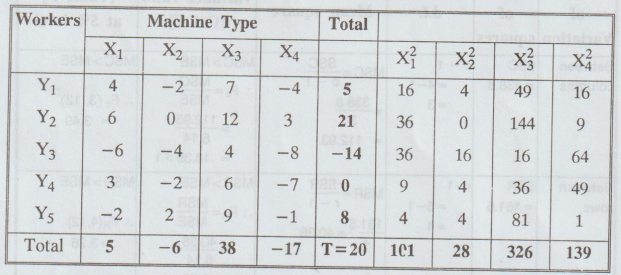
H0
: There is no significant difference between column means as well as row drown
H1
: There is significant difference between column means or the row means.
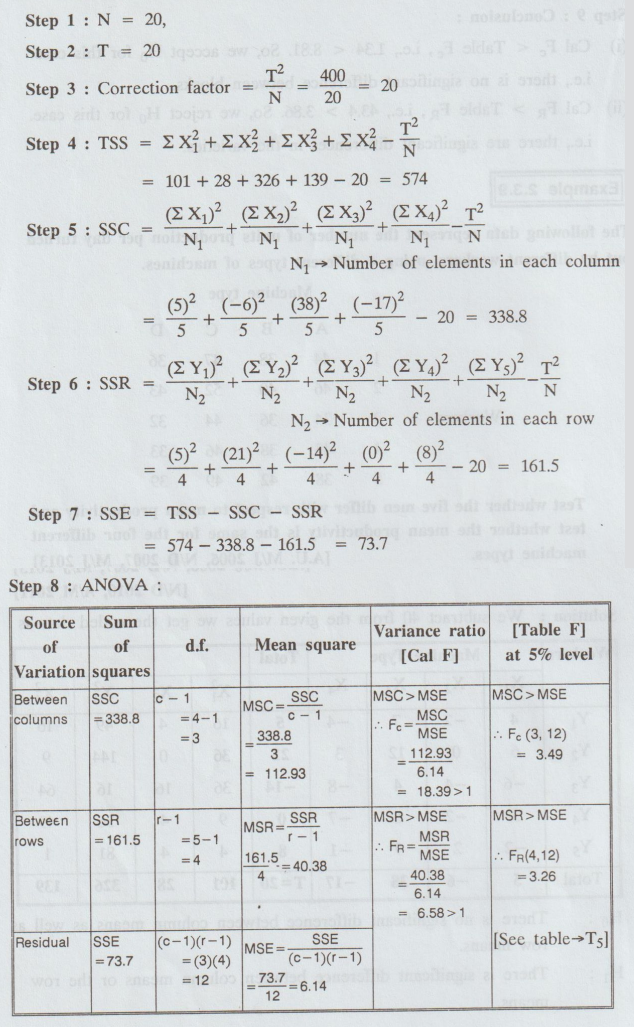
Step
9 Conclusion :
(i) Cal Fe > Table Fe, i.e., 18.39 >
3.49. So, we reject Ho for this case.
i.e.,
there are significant differences in the machines.
(ii)
Cal FR > Table FR, i.e., 6.58 > 3.26. So, we reject Ho for this case.
i.e.,
there are significant differences in the workers.
Hence,
the 5 workers differ significantly and the 4 machine types also differ
significantly with respect to mean productivity.
Example
2.3.10
The
table shows the yield of paddy in arbitrary units obtained from four different
varieties planted in five blocks where each block is divided into four plots.
Test at 5% level whether the yields vary significantly with (i) soil
differences (ii) differences in the type of paddy.
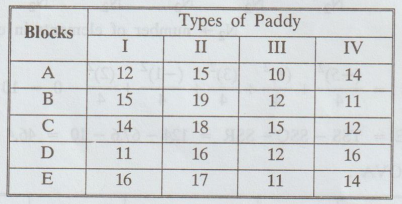
[A.U N/D 2017 (R17)] [A.U N/D 2019 (R17)]
Solution
:
H0
: There is no significant difference between column means as well as row
means.
H1
: There is significant difference between column means or the row means.
EB
SS
Subtract
14 from each number.
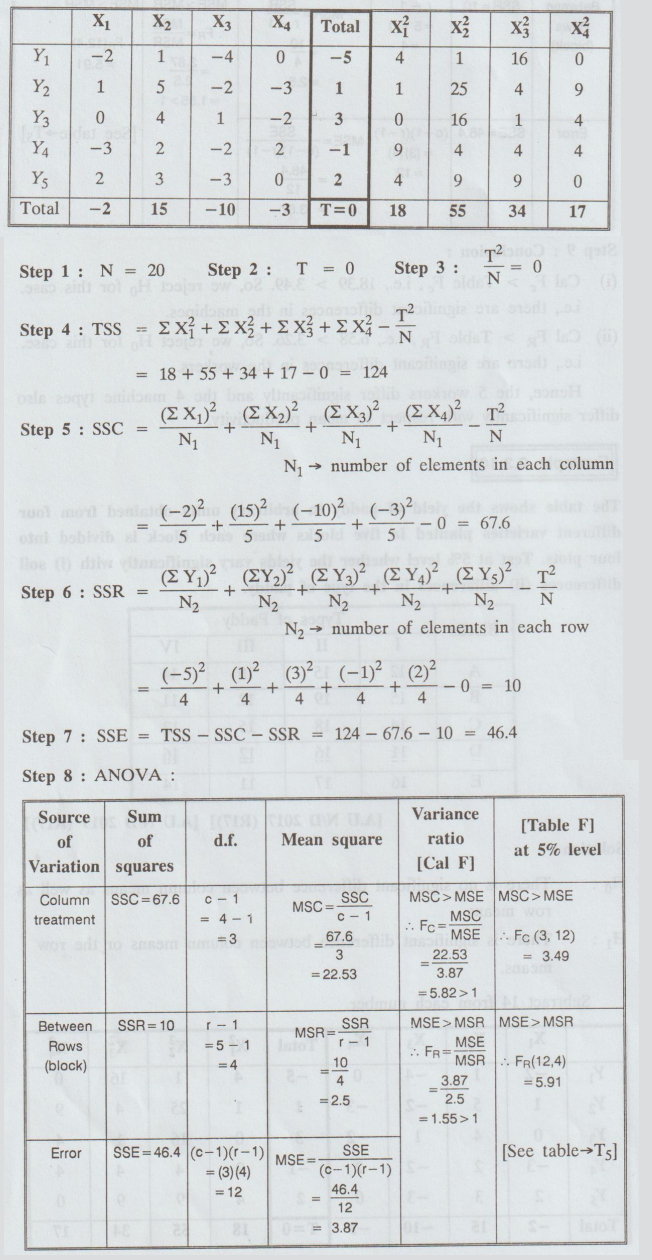
Step
9: Conclusion :
(i) Cal Fe > Table Fe, i.e., 5.82 > 3.49.
So, we reject H0 for this case.
i.e.,
there are significant differences between types of paddy.
(ii)
Cal FR < Table FR, i.e., 1.55 < 5.91. So, we accept H0 for
this case.
i.e.,
there is no significant difference in the blocks.
Example
2.3.11
Table
below shows the seeds of 4 different types of corns planted in 3 blocks. Test
at 0.05 level of significance whether the yields in kilograms per unit area
vary significantly with different types of corns.
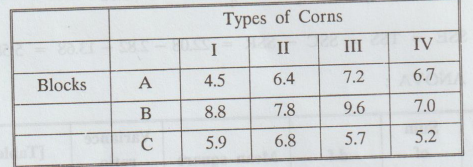
[A.U A/M 2019 R-17] [A.U N/D 2020 R-17]
Solution
:
H0
: There is no significant difference between blocks and types of
corns.
H1
: There is significant difference between blocks and types of corns.
Subtract
6.8 from all the numbers
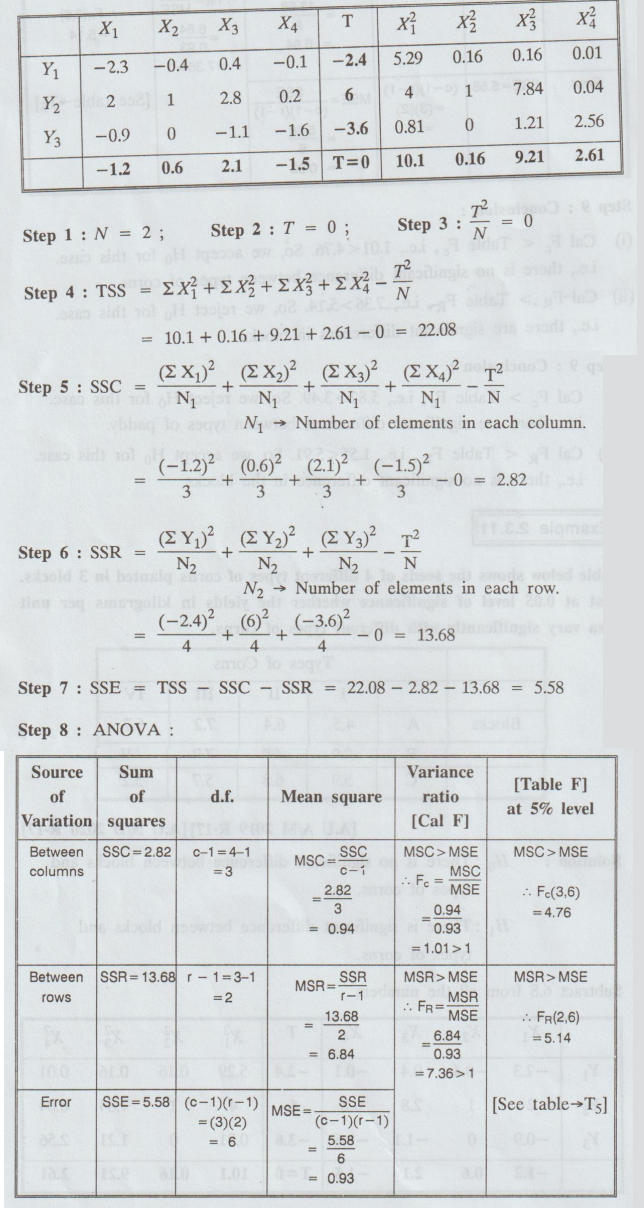
Step
9: Conclusion :
(i)
Cal Fe < Table Fe, i.e., 1.01 <4.76. So, we accept H0 for this
case.
i.e.,
there is no significant difference between types of corns.
(ii)
Cal-FR.> Table FR i.e., 7.36 > 5.14. So, we reject
Ho for this case.
i.e.,
there are significant differences in blocks. 0+ 1.01
Statistics and Numerical Methods: Unit II: Design of Experiments : Tag: : Merits, Demerits, Solved Example Problems | Design of Experiments | Statistics - Two - Way Classification
Related Topics
Related Subjects
Statistics and Numerical Methods
MA3251 2nd Semester 2021 Regulation M2 Engineering Mathematics 2 | 2nd Semester Common to all Dept 2021 Regulation
